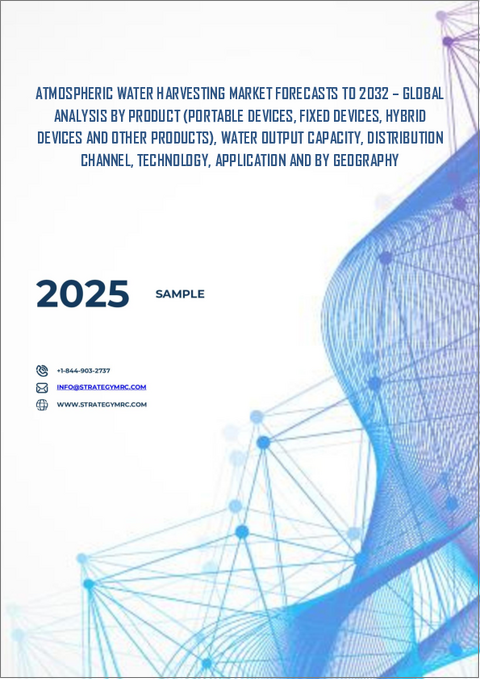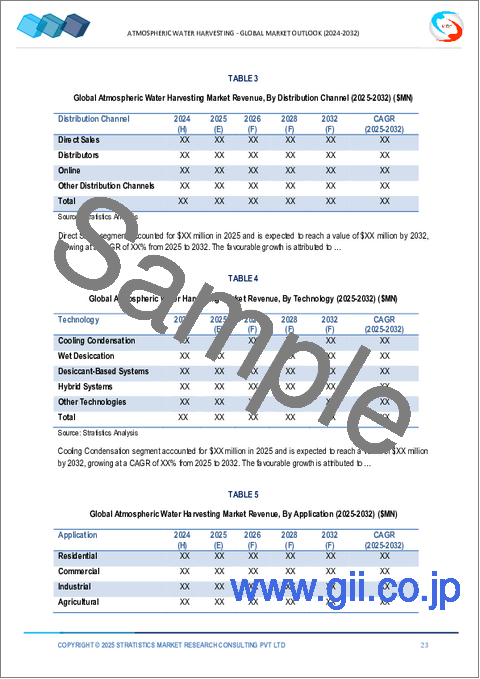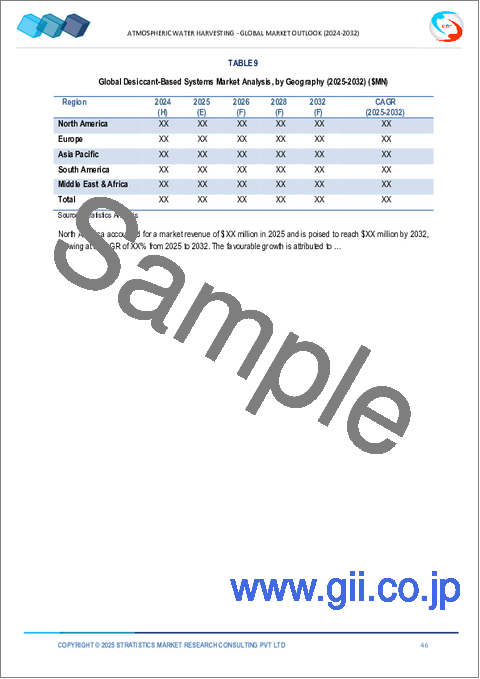|
|
市場調査レポート
商品コード
1802996
大気水採水の世界市場:将来予測 (2032年まで) - 製品別・採水能力別・流通チャネル別・技術別・用途別・地域別の分析Atmospheric Water Harvesting Market Forecasts to 2032 - Global Analysis By Product (Portable Devices, Fixed Devices, Hybrid Devices and Other Products), Water Output Capacity, Distribution Channel, Technology, Application and By Geography |
||||||
カスタマイズ可能
|
|||||||
| 大気水採水の世界市場:将来予測 (2032年まで) - 製品別・採水能力別・流通チャネル別・技術別・用途別・地域別の分析 |
|
出版日: 2025年09月07日
発行: Stratistics Market Research Consulting
ページ情報: 英文 200+ Pages
納期: 2~3営業日
|
全表示
- 概要
- 図表
- 目次
Stratistics MRCによると、世界の大気水採水市場は2025年に39億米ドルを占め、予測期間中にCAGR 17.2%で成長し、2032年には117億米ドルに達する見込みです。
大気水採水(AWH、大気中ウォーターハーベスティング)は、空気中の水蒸気を直接捕捉し、液体の水に凝縮させる持続可能な技術です。AWHは、乾燥剤ベースのシステムや冷却ベースの凝縮器などの技術を使用することで、地下水の利用可能性が低い乾燥地域でも水を生成することができます。従来の水源とは独立して作動するため、分散型のオフグリッド・アプリケーションに最適です。AWHシステムは、スマート・インフラ、災害救援、気候変動に強い農業への統合が進んでいます。世界的な水不足が深刻化する中、AWHは、周囲の湿度を活用し、淡水資源への依存を減らし、エネルギー効率に優れ、スケーラブルなイノベーションを通じて循環型水経済をサポートすることで、有望なソリューションを提供しています。
慢性的な水不足
慢性的な水不足は、大気水採水(AWH)の技術革新を促進し、ニッチ技術から不可欠なソリューションへと変貌させています。伝統的な水源が減少するにつれて、分散型でエネルギー効率の高い水生成への需要が、特に乾燥地帯や災害の多い地域で高まっています。水不足は、投資、政策支援、AWHシステムの採用を加速させ、凝縮効率と太陽電池駆動設計の飛躍的進歩を促します。この緊急性は、回復力のあるインフラストラクチャーを育成し、持続可能なアクセスによってコミュニティに力を与え、AWHを気候に適応した水戦略の要として位置づけています。
エネルギー集約度とコスト
エネルギー集約度の高さと運転コストの上昇がAWH市場に悪影響を及ぼし、コストに敏感な地域では採用が難しくなっています。エネルギーを必要とする技術は、水生産全体の価格を上昇させ、従来の水源に対する競合を低下させます。これは拡張性を妨げ、特に手頃な価格が重要な新興経済諸国での普及を制限します。高価な電力投入への依存は、長期的な持続可能性をさらに抑制し、水不足の課題が高まっているにもかかわらず、市場の成長を鈍化させます。
気候変動
不規則な湿度、気温の変化、天候サイクルの激化に象徴される気候変動は、大気水採水(AWH)の技術革新を促しています。こうした変動は露点の変動や蒸気密度を高め、乾燥地帯や半乾燥地帯における水収量の可能性を高めています。従来の水源が衰える中、AWHは水の安全保障のための回復力のある分散型ソリューションとして浮上しています。気候適応の緊急性は、吸着材、パッシブコンデンサー、スケーラブルな展開への投資を加速させ、AWHを変革的なインパクトを持つ気候適応技術として位置づけています。
設備投資と規模
高額な設備投資と規模拡大の課題が市場に悪影響を与え、普及を妨げています。AWH技術は、インフラ、調査、導入に多額の先行投資を必要とすることが多く、小規模な事業者やコストに敏感な地域にとっては利用しにくいものとなっています。さらに、より多くの人口や産業に対応するためのシステムの拡張は複雑で、商業的な実現可能性を制限しています。このような財政的・経営的障壁が市場浸透を遅らせ、AWGソリューションのニッチから主流への移行を遅らせています。
COVID-19の影響
COVID-19の大流行は、大気水採水市場にさまざまな影響を与えました。当初、サプライチェーンの混乱、プロジェクトの遅延、投資の減少が市場の成長を妨げました。しかし、この危機は信頼できる分散型水源の重要性を浮き彫りにし、革新的なハーベスティング技術への関心を高めました。パンデミックの間、健康、衛生、持続可能な水へのアクセスに対する懸念の高まりは、政府、産業、家庭を、将来の水の安全保障のための弾力的なソリューションとしてAWGシステムを検討するよう駆り立てました。
予測期間中、ハイブリッド・デバイス・セグメントが最大になる見込み
予測期間中、ハイブリッド・デバイス・セグメントが最大の市場シェアを占めると予想されます。これは、多様な気候にわたって効率を高めるサーモエレクトリック技術と吸着技術によるものです。これらの多機能システムは、24時間体制での水の捕獲を可能にし、エネルギー依存を低減し、非電化地域や災害の多い地域の拡張性を高めます。受動的なメカニズムと能動的なメカニズムを融合させたハイブリッド・デバイスは、都市部でも農村部でも展開を加速し、分散型水インフラと気候変動に強い資源管理のイノベーションを促進しながら、きれいな水への持続可能なアクセスを促進します。
予測期間中、農業分野のCAGRが最も高くなる見込み
予測期間中、水不足に対処するための持続可能な解決策を求める農家が増加しているため、農業分野が最も高い成長率を示すと予測されます。AWH技術は、灌漑、作物の生育、家畜の必要性に対して、信頼できる分散型の清浄な水源を提供し、枯渇しつつある地下水への依存を軽減します。気候変動が増大し、降雨パターンが不規則になる中、農業がAWHを採用することは、食糧安全保障を支え、回復力を高めます。このような農業コミュニティからの需要の高まりは、市場の拡大と長期的な存続を大きく加速させます。
最大のシェアを占める地域
予測期間中、アジア太平洋地域は、水不足、都市化、気候変動の課題の増加により、最大の市場シェアを占めると予想されます。インド、中国、オーストラリアのような国々は、乾燥地帯や半乾燥地帯における持続可能な水供給を確保するために、AWH技術を積極的に採用しています。再生可能な水源を推進する政府の取り組みと、凝縮・吸着法の技術進歩が、採用に拍車をかけています。さらに、この地域の産業・農業セクターの拡大により、AWHへの依存度が高まっており、長期的な水安全保障のための重要なソリューションとして位置づけられています。
CAGRが最も高い地域:
予測期間中、水不足に対する懸念の高まりと持続可能な水源へのニーズから、北米地域が最も高いCAGRを示すと予測されます。同地域では、先端技術、再生可能エネルギーの統合、環境に優しいソリューションを推進する政府の取り組みに重点が置かれており、導入が加速しています。都市化の進展に伴う工業用水や農業用水の需要の増加が、市場の拡大をさらに後押ししています。さらに、清潔な水へのアクセスに対する意識の高まりと、弾力性のあるインフラへの取り組みが、北米での市場開拓を後押ししています。
無料のカスタマイズサービス
当レポートをご購読のお客様には、以下の無料カスタマイズオプションのいずれかをご利用いただけます:
- 企業プロファイル
- 追加企業の包括的プロファイリング(3社まで)
- 主要企業のSWOT分析(3社まで)
- 地域区分
- 顧客の関心に応じた主要国の市場推計・予測・CAGR(注:フィージビリティチェックによる)
- 競合ベンチマーキング
- 製品ポートフォリオ、地理的プレゼンス、戦略的提携に基づく主要企業のベンチマーキング
目次
第1章 エグゼクティブサマリー
第2章 序論
- 概要
- ステークホルダー
- 分析範囲
- 分析手法
- データマイニング
- データ分析
- データ検証
- 分析アプローチ
- 分析資料
- 一次調査資料
- 二次調査情報源
- 前提条件
第3章 市場動向の分析
- 促進要因
- 抑制要因
- 市場機会
- 脅威
- 製品分析
- 技術分析
- 用途分析
- 新興市場
- 新型コロナウイルス感染症 (COVID-19) の影響
第4章 ポーターのファイブフォース分析
- サプライヤーの交渉力
- バイヤーの交渉力
- 代替製品の脅威
- 新規参入企業の脅威
- 企業間競争
第5章 世界の大気水採水市場:製品別
- ポータブルデバイス
- 固定デバイス
- ハイブリッドデバイス
- その他の製品
第6章 世界の大気水採水市場:採水能力別
- 20リットル/日以下
- 21~100リットル/日
- 100リットル/日以上
第7章 世界の大気水採水市場:流通チャネル別
- 直接販売
- 販売代理店
- オンライン
- その他の流通チャネル
第8章 世界の大気水採水市場:技術別
- 冷却結露
- 湿潤乾燥
- 乾燥剤ベースシステム
- ハイブリッドシステム
- その他の技術
第9章 世界の大気水採水市場:用途別
- 住宅
- 商業
- 産業
- 農業
- その他の用途
第10章 世界の大気水採水市場:地域別
- 北米
- 米国
- カナダ
- メキシコ
- 欧州
- ドイツ
- 英国
- イタリア
- フランス
- スペイン
- その他欧州
- アジア太平洋
- 日本
- 中国
- インド
- オーストラリア
- ニュージーランド
- 韓国
- その他アジア太平洋
- 南米
- アルゼンチン
- ブラジル
- チリ
- その他南米
- 中東・アフリカ
- サウジアラビア
- アラブ首長国連邦
- カタール
- 南アフリカ
- その他中東・アフリカ
第11章 主な動向
- 契約、事業提携・協力、合弁事業
- 企業合併・買収 (M&A)
- 新製品の発売
- 事業拡張
- その他の主要戦略
第12章 企業プロファイリング
- Source Global
- Air2Water LLC
- Oasis Park
- Akvo Atmospheric Water Systems Pvt. Ltd.
- ExaWater
- Atlantis Solar Environmental Products
- Aeraqua Solutions
- Canadian Dew Technologies Inc.
- Hydrexa
- Drinkable Air, Inc.
- ATMOS
- EcoloBlue, Inc.
- AirJoule
- Energy and Water Development Corp.
- RePG Enerji Sistemleri
- Watergen Ltd.
- Aqua Ubique
- Skywater
- Infinite Water Inc.
- Dew Point Manufacturing
List of Tables
- Table 1 Global Atmospheric Water Harvesting Market Outlook, By Region (2024-2032) ($MN)
- Table 2 Global Atmospheric Water Harvesting Market Outlook, By Product (2024-2032) ($MN)
- Table 3 Global Atmospheric Water Harvesting Market Outlook, By Portable Devices (2024-2032) ($MN)
- Table 4 Global Atmospheric Water Harvesting Market Outlook, By Fixed Devices (2024-2032) ($MN)
- Table 5 Global Atmospheric Water Harvesting Market Outlook, By Hybrid Devices (2024-2032) ($MN)
- Table 6 Global Atmospheric Water Harvesting Market Outlook, By Other Products (2024-2032) ($MN)
- Table 7 Global Atmospheric Water Harvesting Market Outlook, By Water Output Capacity (2024-2032) ($MN)
- Table 8 Global Atmospheric Water Harvesting Market Outlook, By Up to 20 Liters/Day (2024-2032) ($MN)
- Table 9 Global Atmospheric Water Harvesting Market Outlook, By 21-100 Liters/Day (2024-2032) ($MN)
- Table 10 Global Atmospheric Water Harvesting Market Outlook, By Above 100 Liters/Day (2024-2032) ($MN)
- Table 11 Global Atmospheric Water Harvesting Market Outlook, By Distribution Channel (2024-2032) ($MN)
- Table 12 Global Atmospheric Water Harvesting Market Outlook, By Direct Sales (2024-2032) ($MN)
- Table 13 Global Atmospheric Water Harvesting Market Outlook, By Distributors (2024-2032) ($MN)
- Table 14 Global Atmospheric Water Harvesting Market Outlook, By Online (2024-2032) ($MN)
- Table 15 Global Atmospheric Water Harvesting Market Outlook, By Other Distribution Channels (2024-2032) ($MN)
- Table 16 Global Atmospheric Water Harvesting Market Outlook, By Technology (2024-2032) ($MN)
- Table 17 Global Atmospheric Water Harvesting Market Outlook, By Cooling Condensation (2024-2032) ($MN)
- Table 18 Global Atmospheric Water Harvesting Market Outlook, By Wet Desiccation (2024-2032) ($MN)
- Table 19 Global Atmospheric Water Harvesting Market Outlook, By Desiccant-Based Systems (2024-2032) ($MN)
- Table 20 Global Atmospheric Water Harvesting Market Outlook, By Hybrid Systems (2024-2032) ($MN)
- Table 21 Global Atmospheric Water Harvesting Market Outlook, By Other Technologies (2024-2032) ($MN)
- Table 22 Global Atmospheric Water Harvesting Market Outlook, By Application (2024-2032) ($MN)
- Table 23 Global Atmospheric Water Harvesting Market Outlook, By Residential (2024-2032) ($MN)
- Table 24 Global Atmospheric Water Harvesting Market Outlook, By Commercial (2024-2032) ($MN)
- Table 25 Global Atmospheric Water Harvesting Market Outlook, By Industrial (2024-2032) ($MN)
- Table 26 Global Atmospheric Water Harvesting Market Outlook, By Agricultural (2024-2032) ($MN)
- Table 27 Global Atmospheric Water Harvesting Market Outlook, By Other Applications (2024-2032) ($MN)
Note: Tables for North America, Europe, APAC, South America, and Middle East & Africa Regions are also represented in the same manner as above.
According to Stratistics MRC, the Global Atmospheric Water Harvesting Market is accounted for $3.9 billion in 2025 and is expected to reach $11.7 billion by 2032 growing at a CAGR of 17.2% during the forecast period. Atmospheric Water Harvesting (AWH) is a sustainable technique that captures water vapor directly from the air and condenses it into liquid water. Using technologies like desiccant-based systems or cooling-based condensers, AWH enables water generation even in arid regions with low groundwater availability. It operates independently of traditional water sources, making it ideal for decentralized, off-grid applications. AWH systems are increasingly integrated into smart infrastructure, disaster relief, and climate-resilient agriculture. As global water scarcity intensifies, AWH offers a promising solution by leveraging ambient humidity, reducing reliance on freshwater reserves, and supporting circular water economies through energy-efficient, scalable innovation.
Market Dynamics:
Driver:
Chronic water scarcity
Chronic water scarcity is catalyzing innovation in Atmospheric Water Harvesting (AWH), transforming it from niche tech to a vital solution. As traditional sources dwindle, demand for decentralized, energy-efficient water generation grows-especially in arid and disaster-prone regions. Scarcity accelerates investment, policy support, and adoption of AWH systems, driving breakthroughs in condensation efficiency and solar-powered designs. This urgency fosters resilient infrastructure and empowers communities with sustainable access, positioning AWH as a cornerstone of climate-adaptive water strategy.
Restraint:
Energy intensity & cost
High energy intensity and rising operational costs are negatively impacting the AWH market, making adoption less feasible for cost-sensitive regions. Energy-demanding technologies increase the overall price of water production, reducing competitiveness against conventional water sources. This hinders scalability and limits widespread deployment, particularly in developing economies where affordability is crucial. The dependence on expensive power inputs further restrains long-term sustainability, slowing market growth despite rising water scarcity challenges.
Opportunity:
Climate volatility
Climate volatility-marked by erratic humidity, temperature shifts, and intensified weather cycles-is catalyzing innovation in atmospheric water harvesting (AWH). These fluctuations enhance dew point variability and vapor density, boosting water yield potential in arid and semi-arid zones. As traditional sources falter, AWH emerges as a resilient, decentralized solution for water security. The urgency of climate adaptation is accelerating investment in sorbent materials, passive condensers, and scalable deployment, positioning AWH as a climate-aligned technology with transformative impact.
Threat:
Capex & scale
High capital expenditure and scaling challenges are negatively impacting the market, hindering widespread adoption. The technology often demands significant upfront investment in infrastructure, research, and deployment, making it less accessible to smaller players and cost-sensitive regions. Additionally, scaling systems to serve larger populations or industries proves complex, limiting commercial viability. These financial and operational barriers slow down market penetration, delaying the transition of AWG solutions from niche to mainstream adoption.
Covid-19 Impact
The Covid-19 pandemic had a mixed impact on the Atmospheric Water Harvesting market. Initially, supply chain disruptions, project delays, and reduced investments hindered market growth. However, the crisis highlighted the importance of reliable and decentralized water sources, boosting interest in innovative harvesting technologies. Rising concerns over health, hygiene, and sustainable water access during the pandemic drove governments, industries, and households to consider AWG systems as a resilient solution for future water security.
The hybrid device segment is expected to be the largest during the forecast period
The hybrid device segment is expected to account for the largest market share during the forecast period, due to thermoelectric, and sorption technologies to boost efficiency across diverse climates. These multi-functional systems enable round-the-clock water capture, reduce energy dependency, and enhance scalability for off-grid and disaster-prone regions. By merging passive and active mechanisms, hybrid devices accelerate deployment in urban and rural settings alike, driving sustainable access to clean water while catalyzing innovation in decentralized water infrastructure and climate-resilient resource management.
The agricultural segment is expected to have the highest CAGR during the forecast period
Over the forecast period, the agricultural segment is predicted to witness the highest growth rate as farmers increasingly seek sustainable solutions to address water scarcity. AWH technologies provide a reliable, decentralized source of clean water for irrigation, crop growth, and livestock needs, reducing dependence on depleting groundwater reserves. With rising climate variability and erratic rainfall patterns, agriculture's adoption of AWH supports food security and enhances resilience. This growing demand from farming communities significantly accelerates the market's expansion and long-term viability.
Region with largest share:
During the forecast period, the Asia Pacific region is expected to hold the largest market share due to rising water scarcity, urbanization, and climate change challenges. Countries like India, China, and Australia are actively adopting AWH technologies to ensure sustainable water supply in arid and semi-arid zones. Government initiatives promoting renewable water sources, coupled with technological advancements in condensation and adsorption methods, are fueling adoption. Moreover, the region's expanding industrial and agricultural sectors increasingly rely on AWH, positioning it as a vital solution for long-term water security.
Region with highest CAGR:
Over the forecast period, the North America region is anticipated to exhibit the highest CAGR, owing to rising concerns over water scarcity and the need for sustainable water sources. The region's focus on advanced technologies, renewable energy integration, and government initiatives promoting eco-friendly solutions are accelerating adoption. Growing industrial and agricultural demand, alongside increasing urbanization, is further fueling market expansion. Additionally, heightened awareness of clean water access and the push toward resilient infrastructure are positively shaping the market's development in North America.
Key players in the market
Some of the key players profiled in the Atmospheric Water Harvesting Market include Source Global, Air2Water LLC, Oasis Park, Akvo Atmospheric Water Systems Pvt. Ltd., ExaWater, Atlantis Solar Environmental Products, Aeraqua Solutions, Canadian Dew Technologies Inc., Hydrexa, Drinkable Air, Inc., ATMOS, EcoloBlue, Inc., AirJoule, Energy and Water Development Corp., RePG Enerji Sistemleri, Watergen Ltd., Aqua Ubique, Skywater, Infinite Water Inc. and Dew Point Manufacturing.
Key Developments:
In April 2025, AirJoule Technologies Corporation announced an agreement with Arizona State University ("ASU"). Under the binding agreement, ASU will purchase one AirJoule(R) A250TM unit, a high-capacity system capable of producing 250 liters of pure distilled water per day directly from ambient air.
In February 2025, SkyWater Technology entered a strategic partnership with Infineon to acquire its 200mm fab in Austin, Texas. The deal includes a long-term supply agreement and aims to expand U.S. foundry capacity for foundational chips.
Products Covered:
- Portable Devices
- Fixed Devices
- Hybrid Devices
- Other Products
Water Output Capacities Covered:
- Up to 20 Liters/Day
- 21-100 Liters/Day
- Above 100 Liters/Day
Distribution Channels Covered:
- Direct Sales
- Distributors
- Online
- Other Distribution Channels
Technologies Covered:
- Cooling Condensation
- Wet Desiccation
- Desiccant-Based Systems
- Hybrid Systems
- Other Technologies
Applications Covered:
- Residential
- Commercial
- Industrial
- Agricultural
- Other Applications
Regions Covered:
- North America
- US
- Canada
- Mexico
- Europe
- Germany
- UK
- Italy
- France
- Spain
- Rest of Europe
- Asia Pacific
- Japan
- China
- India
- Australia
- New Zealand
- South Korea
- Rest of Asia Pacific
- South America
- Argentina
- Brazil
- Chile
- Rest of South America
- Middle East & Africa
- Saudi Arabia
- UAE
- Qatar
- South Africa
- Rest of Middle East & Africa
What our report offers:
- Market share assessments for the regional and country-level segments
- Strategic recommendations for the new entrants
- Covers Market data for the years 2024, 2025, 2026, 2028, and 2032
- Market Trends (Drivers, Constraints, Opportunities, Threats, Challenges, Investment Opportunities, and recommendations)
- Strategic recommendations in key business segments based on the market estimations
- Competitive landscaping mapping the key common trends
- Company profiling with detailed strategies, financials, and recent developments
- Supply chain trends mapping the latest technological advancements
Free Customization Offerings:
All the customers of this report will be entitled to receive one of the following free customization options:
- Company Profiling
- Comprehensive profiling of additional market players (up to 3)
- SWOT Analysis of key players (up to 3)
- Regional Segmentation
- Market estimations, Forecasts and CAGR of any prominent country as per the client's interest (Note: Depends on feasibility check)
- Competitive Benchmarking
- Benchmarking of key players based on product portfolio, geographical presence, and strategic alliances
Table of Contents
1 Executive Summary
2 Preface
- 2.1 Abstract
- 2.2 Stake Holders
- 2.3 Research Scope
- 2.4 Research Methodology
- 2.4.1 Data Mining
- 2.4.2 Data Analysis
- 2.4.3 Data Validation
- 2.4.4 Research Approach
- 2.5 Research Sources
- 2.5.1 Primary Research Sources
- 2.5.2 Secondary Research Sources
- 2.5.3 Assumptions
3 Market Trend Analysis
- 3.1 Introduction
- 3.2 Drivers
- 3.3 Restraints
- 3.4 Opportunities
- 3.5 Threats
- 3.6 Product Analysis
- 3.7 Technology Analysis
- 3.8 Application Analysis
- 3.9 Emerging Markets
- 3.10 Impact of Covid-19
4 Porters Five Force Analysis
- 4.1 Bargaining power of suppliers
- 4.2 Bargaining power of buyers
- 4.3 Threat of substitutes
- 4.4 Threat of new entrants
- 4.5 Competitive rivalry
5 Global Atmospheric Water Harvesting Market, By Product
- 5.1 Introduction
- 5.2 Portable Devices
- 5.3 Fixed Devices
- 5.4 Hybrid Devices
- 5.5 Other Products
6 Global Atmospheric Water Harvesting Market, By Water Output Capacity
- 6.1 Introduction
- 6.2 Up to 20 Liters/Day
- 6.3 21-100 Liters/Day
- 6.4 Above 100 Liters/Day
7 Global Atmospheric Water Harvesting Market, By Distribution Channel
- 7.1 Introduction
- 7.2 Direct Sales
- 7.3 Distributors
- 7.4 Online
- 7.5 Other Distribution Channels
8 Global Atmospheric Water Harvesting Market, By Technology
- 8.1 Introduction
- 8.2 Cooling Condensation
- 8.3 Wet Desiccation
- 8.4 Desiccant-Based Systems
- 8.5 Hybrid Systems
- 8.6 Other Technologies
9 Global Atmospheric Water Harvesting Market, By Application
- 9.1 Introduction
- 9.2 Residential
- 9.3 Commercial
- 9.4 Industrial
- 9.5 Agricultural
- 9.6 Other Applications
10 Global Atmospheric Water Harvesting Market, By Geography
- 10.1 Introduction
- 10.2 North America
- 10.2.1 US
- 10.2.2 Canada
- 10.2.3 Mexico
- 10.3 Europe
- 10.3.1 Germany
- 10.3.2 UK
- 10.3.3 Italy
- 10.3.4 France
- 10.3.5 Spain
- 10.3.6 Rest of Europe
- 10.4 Asia Pacific
- 10.4.1 Japan
- 10.4.2 China
- 10.4.3 India
- 10.4.4 Australia
- 10.4.5 New Zealand
- 10.4.6 South Korea
- 10.4.7 Rest of Asia Pacific
- 10.5 South America
- 10.5.1 Argentina
- 10.5.2 Brazil
- 10.5.3 Chile
- 10.5.4 Rest of South America
- 10.6 Middle East & Africa
- 10.6.1 Saudi Arabia
- 10.6.2 UAE
- 10.6.3 Qatar
- 10.6.4 South Africa
- 10.6.5 Rest of Middle East & Africa
11 Key Developments
- 11.1 Agreements, Partnerships, Collaborations and Joint Ventures
- 11.2 Acquisitions & Mergers
- 11.3 New Product Launch
- 11.4 Expansions
- 11.5 Other Key Strategies
12 Company Profiling
- 12.1 Source Global
- 12.2 Air2Water LLC
- 12.3 Oasis Park
- 12.4 Akvo Atmospheric Water Systems Pvt. Ltd.
- 12.5 ExaWater
- 12.6 Atlantis Solar Environmental Products
- 12.7 Aeraqua Solutions
- 12.8 Canadian Dew Technologies Inc.
- 12.9 Hydrexa
- 12.10 Drinkable Air, Inc.
- 12.11 ATMOS
- 12.12 EcoloBlue, Inc.
- 12.13 AirJoule
- 12.14 Energy and Water Development Corp.
- 12.15 RePG Enerji Sistemleri
- 12.16 Watergen Ltd.
- 12.17 Aqua Ubique
- 12.18 Skywater
- 12.19 Infinite Water Inc.
- 12.20 Dew Point Manufacturing






